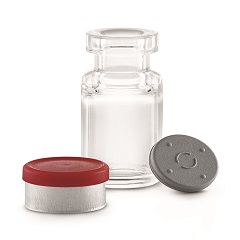Glass Versus Cyclic Olefin Polymers Container Closure Integrity in Cryogenic Storage Environments
Many biologic drugs require low-temperature storage under certain conditions, all the way down to the cryogenic range (-180 oC). Such low temperatures can be problematic for glass vials. If the glass vial for a biologic drug experiences breakage, or does not maintain container closure integrity, a cyclic olefin polymer (COP) system may be the solution. COP has several features that make it suitable for drug packaging. It is transparent and fracture-resistant, offers resistance to oxygen and water and has the ability to maintain container closure integrity at low temperature.

Glass has been used to store and deliver drugs for years; however, it presents several issues:
- Glass is intrinsically brittle. At low temperatures, it is even more brittle and agitation from shipping/handling increases the likelihood of fracture.
- Glass is not inert. It can negatively interact with a biologic drug product. Leachables from glass pose the same risk. Delamination—the presence of glass flakes in a drug product, causing detachment from the glass surface—is another issue (1). Since 2010, delamination has caused many product recalls and FDA has issued an advisory on its website (2).
- Glass poses a risk of loss of container closure integrity. At cryogenic temperatures, glass and rubber are fundamentally incompatible, resulting in the high likelihood of a container closure integrity failure of a vial/stopper system (3). The substantially different coefficients of thermal expansion—rubber shrinks much more than glass—results in gap formation. In contrast, rubber and COP shrink at comparable rates, substantially reducing the risk of gap formation that results in loss of container closure integrity.
| Vial Type | O2 Concentration (%) | |
|---|---|---|
| T = 0 days | T = 8 days | |
| COP | 20.1 | 19.4 |
| Glass | 20.4 | 8.0 |
So, how do COP vials compare with traditional glass cryogenic temperatures? A recent study looked at how glass and COP vials respond to cryogenic temperatures. Two different vial/stopper systems (one consisting of 2 mL glass and another comprised of COP with 13 mm rubber serum) were filled with air and placed in a liquid nitrogen chamber (approx. -165oC) for eight days. With frequency-modulated spectroscopy, the O2 concentration in the vials was measured. Table 1 shows the results of this study.
The COP vial showed only a very slight change in O2 concentration. In contrast, the glass system showed a substantial change consistent with a leak resulting from the rubber stopper pulling away from the glass vial.
In summary, a system comprising a COP vial and a rubber stopper can be a choice for storing biologic drugs. In addition to the many benefits of COP, the system enables optimal container closure integrity at cryogenic temperatures, whereas a system using a glass vial may not.
References
- “The Causes and Implications of Glass Delamination.” Pharmaceutical Technology 6 (2011) supplement. https://www.pharmtech.com/view/causes-and-implications-glass-delamination (Accessed April 24, 2018)
- “Advisory to Drug Manufacturers: Formation of Glass Lamellae in Certain Injectable Drugs.” U.S. FDA. March 25, 2011 https://wayback.archive-it.org/7993/20170113073826/http:/www.fda.gov/Drugs/DrugSafety/ucm248490.htm (Accessed April 24, 2018)
- Coefficients of Linear Thermal Expansion. Engineering ToolBox (2003) https://www.engineeringtoolbox.com/linear-expansion-coefficients-d_95.html (Accessed April 24, 2018)



 James McCaw is the supervisor of the Container Closure Integrity group, West Analytical Services.
James McCaw is the supervisor of the Container Closure Integrity group, West Analytical Services.